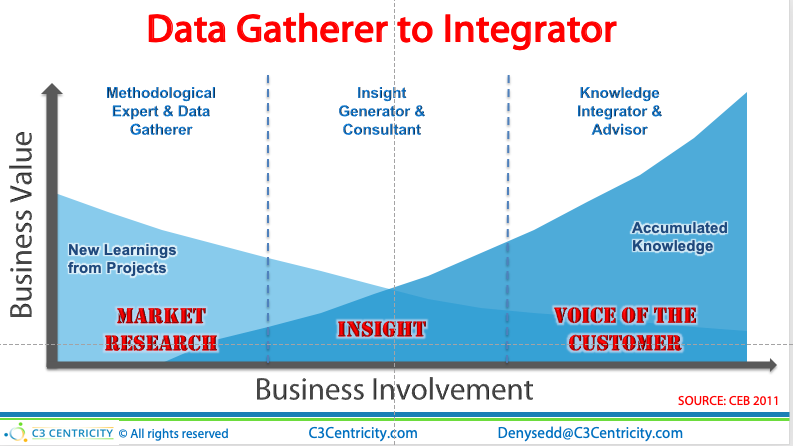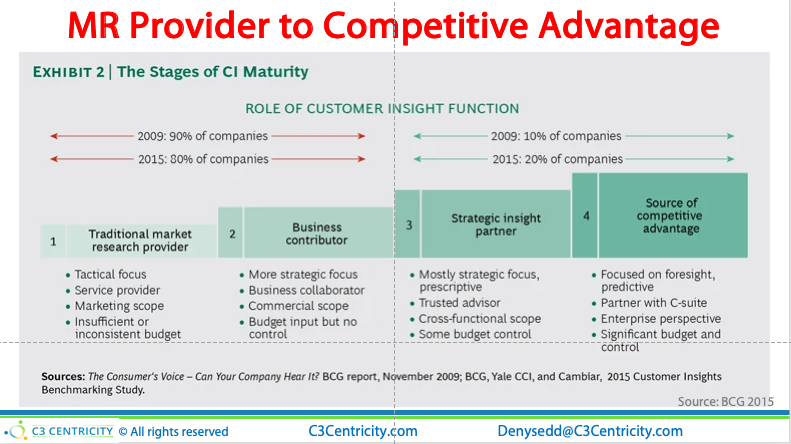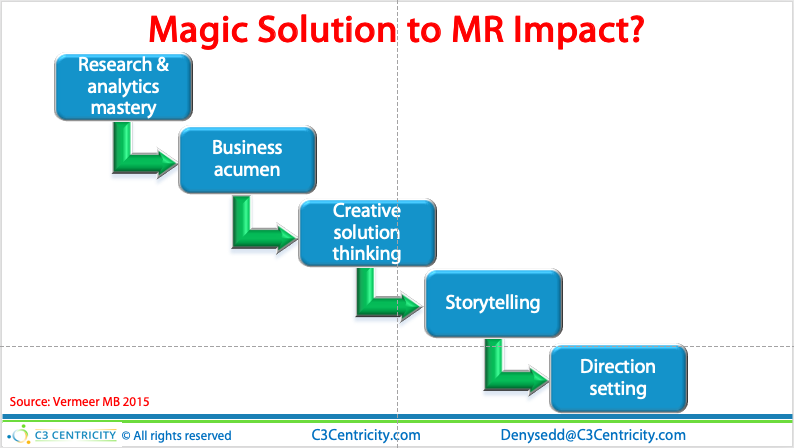It is a well-known fact that when budgets are tight, marketing is usually one of the first departments to suffer cuts, and market research in particular!
Why is this? I believe it is because their ROI is longer-term and often difficult to prove. They therefore make the perfect target for sweeping reductions. What they all need is a strategic growth blueprint.
A few years ago, I was asked to talk on this topic at the Planung&Analyse conference in Frankfurt. Despite rave reviews of the talk itself, many commented that they would have liked me to propose some sort of formula to help them to better defend themselves. So I decided to do just that with this post, but first a warning; customer understanding is being lost!
According to research by BurtchWorks, 20.7% of researchers changed jobs after an average of 3.1 years in their position. However, those with over ten years experience showed slightly lower levels of churn (17.8% and 3.4 years)
A study from Spencer Stuart among CMOs of Fortune 500 companies found that the average tenure is 4.2 years, roughly on par with the rest of the C-suite (4.4 years), with B2B companies (4.4 years) slightly better off than B2C (4.1 years).
These numbers made me realise that customer understanding risks being forgotten and then constantly reinvented by newly hired people in marketing and market research positions. What a waste of resources!
But there is something that you can do to increase the ROI of your spending, which is something the C-suite has long demanded of marketing departments.
And that is to develop a CMO Strategic Growth Blueprint that includes reimagining market research and how data and information are used.
Here’s how.
If you prefer to listen rather than read:
The ROI of Market Research
The challenge of proving the value of market research (MR) has also been a hot topic for more than a decade. And yet we didn’t seem to be any closer to solving it, at least until recently. I think that this is because all the studies I have seen on the topic concentrate on identifying what is wrong, but rarely offer help in what to change to provide more visible value to their companies. I want to put this right.
The CEB / Gartner Analysis: This analysis concludes that MR provides two types of value. Firstly from new projects and secondly from accumulated knowledge over time. By plotting these two, they came out with a three-phase progression of how MR can add value to an organisation. (see below)

However, with both marketers and market researchers changing jobs (too) frequently, there is far less accumulated knowledge than previously. But don’t worry I have the solution in the form of a new model of CX, which I will explain in a moment.
The BCG Analysis: A few years after the CEB study, BCG (Boston Consulting Group) updated their own analysis of research they first ran in 2009. They came out with a slightly more differentiated four phases of value for MR as shown in the chart below.

Although over the six years between these two studies, researchers have been valued more as strategic partners and a source of true competitive advantage, the level remains pitifully low at just 20%.
This means that four out of every five MR departments remain in a traditional information provider role. They suffer from a lack of resources, have very little control over their budgets and do not have much recognition in their organisation.
The MB Vermeer Analysis: In the same year as the BCG research, a group of client and supplier side researchers ran a study with Millward Browne, called Insight 2020. It had as its objective to be the definitive roadmap for MR to finally get the respect and resources they need, and that all-important seat at the executive table that they crave. While its results were delivered in great pomp and ceremony, very little has happened since.

So having set the pitiful current situation of marketing and market research and their challenges to prove their ROI, I now have a solution to propose.
The New Strategic Growth Blueprint for Marketing and Market Research
Marketing needs information about its market, its category, its brands, its competitors and its customers. That’s a lot of information! Luckily we work in a data-rich environment with more than enough information readily available.
But information needs to be turned into knowledge and understanding and then actioned if it is to make a difference. So why isn’t this happening and what needs to change to have their required impact?
To truly optimize the impact of market research, professionals must:
1. Have Tighter Alignment with Strategic Objectives
The first order of business is ensuring that market research activities are in sync with the broader strategic objectives of the marketing department and the organization at large. This alignment begins with a deep dive into marketing goals, and identifying areas where market research can deliver the most value. Whether it’s entering a new market, launching a product, or enhancing customer experience, each initiative must be directly tied to a strategic outcome.
Netflix’s strategy for entering international markets showcases this principle very well. The company leverages market research to understand local content preferences, viewing habits, and cultural nuances. This research directly informs content creation, acquisition strategies, and marketing campaigns, ensuring alignment with regional market demands and strategic goals.
Join our Ultimate 60-mins CX Makeover to discover a new way to decrease information investments while simultaneously deepening the knowledge of your market and customers.
2. Embrace Technology to Enhance Understanding
The intersection of market research and marketing is increasingly influenced by technology. The integration of artificial intelligence (AI), machine learning (ML), and big data analytics has revolutionized market research. These technologies enable researchers to process vast amounts of data at unprecedented speeds, uncovering insights that were previously inaccessible.
For instance, AI-powered sentiment analysis tools can analyze customer feedback from social media platforms in real time, providing immediate insights into consumer sentiment and emerging trends.
Consider the use of predictive analytics to identify potential future trends in consumer behaviour. Marketing can leverage this information to design preemptive campaigns that address emerging needs, creating a competitive edge for the company.
Furthermore, predictive analytics can forecast future consumer behaviours, allowing companies to anticipate market shifts and adapt their strategies accordingly. These technological advancements not only enhance the accuracy and relevance of market research insights but also demonstrate MR’s direct impact on strategic decision-making and business performance.
Amazon employs predictive analytics to forecast consumer buying patterns, enabling highly personalized marketing and product recommendations. This not only enhances the customer experience but also significantly boosts sales, demonstrating the tangible ROI of integrating advanced analytics into market research.
3. Demonstrate the Impact of MR by Developing Metrics that Showcase Links to Business Performance
Illustrating the value of market research through tangible examples can significantly bolster its perceived ROI.
Market research must become far more agile, embracing a culture of rapid experimentation, where hypotheses are tested quickly, and insights are iteratively refined. This agile approach reduces the time from insight to action, allowing marketing to adapt its strategies in real time based on actual market feedback.
Google is renowned for its culture of experimentation, often running thousands of A/B tests annually on everything from search algorithms to user interface designs. This relentless experimentation, informed by rigorous market research, ensures that only the most effective changes are implemented, enhancing user experience and engagement.
The Solution
These five essentials of marketing and market research are included in the New CX Model Quantum Customer Centricity or QC2 for short. QC2 embraces the need for better information integration, cross-company collaboration and the optimal use of resources by first analysing what is already known within the organisation before gathering any more data.
QC² and the CATSIGHT™ process of insight development include all these elements. You can find out more about Quantum Customer Centricity in the EBOOK “The Art and Science of QC2 … Beyond CX.”
Conclusion
Marketing’s vision for market research must transcend traditional boundaries. By aligning research initiatives with strategic objectives, leveraging the latest technologies, fostering a culture of experimentation, integrating customer feedback, and encouraging cross-functional collaboration, we can dramatically increase the ROI of market research and thereby also marketing.
This reimagined approach not only enhances our understanding of the market and our customers but also empowers us to make data-driven decisions that drive sustainable growth and competitive advantage. In the end, the value of marketing and market research is measured not just by the insights it generates but by the strategic outcomes it enables.
Does this make sense to you, as a blueprint to respond to marketing and market researchers’ constant demands to prove their ROI to top management? What additional point would you add?
Would you like to make a quantum leap in your business by making small, atomic changes, such as reducing your information investments by up to 65% yet still knowing more about your customers; increasing your innovation success rate; optimising employee motivation and loyalty? Then CONTACT US TODAY. Your organization’s success could be at the end of our call.
This post has been updated from an earlier version that first appeared on C3Centricity in 2020.












